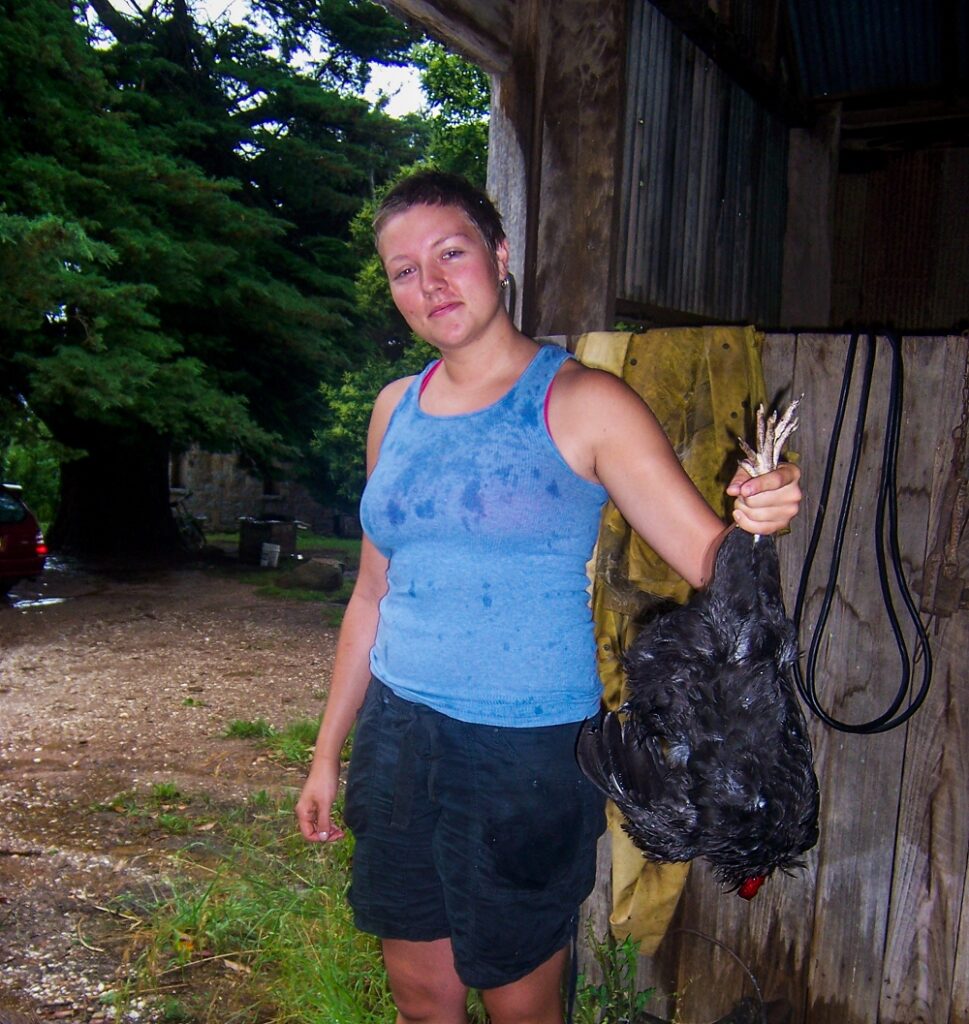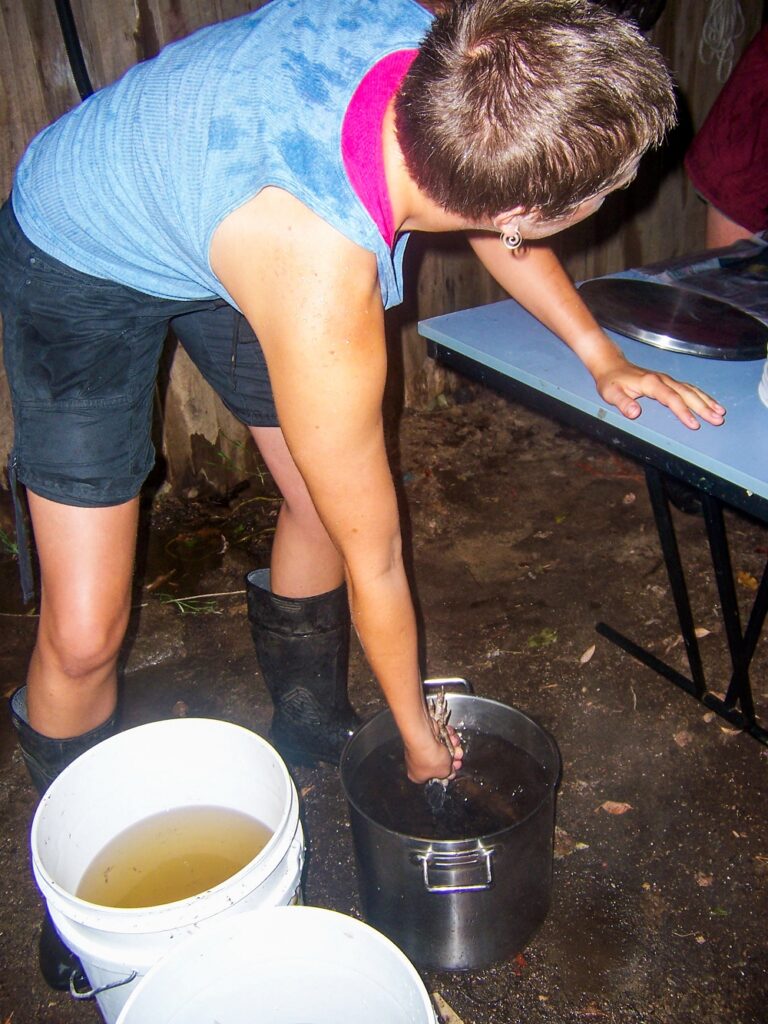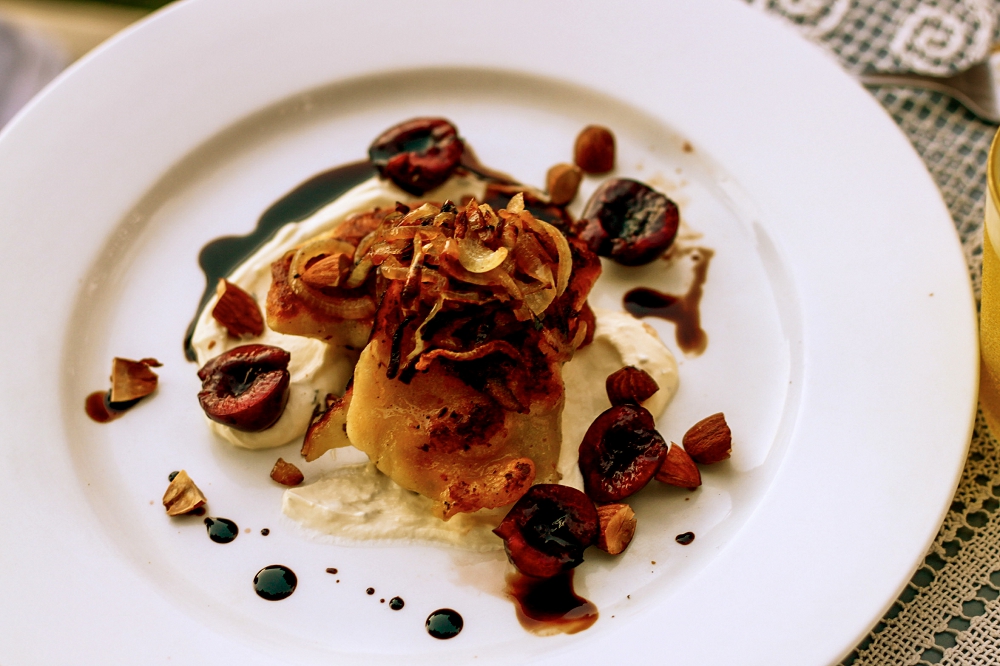As part of our self-sustainable lifestyle, we aim to grow as much of our own food as possible. For us that also means raising and slaughtering home-grown meat.
Related Articles
Saving heritage fruit trees by planting them
Many heritage fruit tree varieties are in danger of going extinct. The best way to save them is by planting them in your backyard.
9-step process for preserving fruit
Learning to preserve your own fruit is a great way to use up gluts and give you a steady fruit supply throughout the year.
Managing your fruit trees and frost
Learn about frost in your garden, how it may affect different types of fruit trees, and how to protect them by creating microclimates.
For a carnivore, learning how to butcher your own meat is a very real way to gain an appreciation of the food that goes into your mouth. (And just a warning, this blog includes photos and details about the entire process.)
Animals and the environment
Animals are a key part of a regenerative food-growing ecosystem. They have an important role in recycling waste food, providing nutrients, and contributing to pest control.
Because of the way a lot of animals are managed in conventional farming systems, they often get a bad rap for causing damage to the environment. But properly managed, they can (and should) have a net positive impact.
At the same time, they’re not just a commodity and should never be treated as such. When farmers (or anyone) choose to “own” animals they are taking on the responsibility to meet the animal’s needs and make sure they have a comfortable and secure life. If you’re raising them for meat, you also have a responsibility to ensure they have a respectful and painless death.
Truth is, home-grown animals contribute an important source of protein to our diet. But we reckon that if you’re going to eat meat then raising, feeding, and slaughtering your own animals (or buying direct from farmers who do) is certainly the most ethical way to do it.

An ethical home-grown chicken adventure
Some years ago we embarked on a very personal “farmyard to table” journey. It was led by Laura, who was staying with us on the farm at the time. Laura was tired of working with factory-farmed chicken in her career as a chef in America. One of her goals while WWOOFing in Australia was to learn how to slaughter meat for herself.
The experience turned out to be a pivotal moment in Laura’s career with meat. She now owns and runs a hugely successful business as Laura the Butcher in Steamboat Springs, Colorado. The business includes the Meatbar charcuterie and winebar, a catering arm, and classes in home butchery and ethical meat consumption.
We were happy to facilitate the process. First up she bought some 6-week-old roosters at the Castlemaine Farmers Market. They were penned next to the rest of our flock so they had company, under a beautiful shady cypress tree with a shed for shelter.
They were fed an abundant diet of rain-damaged cherries and other fruit, locally grown biodynamic wheat, household scraps, and grass and weeds from around the farm.

Slaughter day
When the boys were big enough, slaughter day arrived. Laura and Hugh had researched and constructed a killing cone to facilitate a low-stress experience for the roosters. The roosters were quite tame, so were caught by hand and calmed by covering their eyes.
Then they were quickly upended in the cone. The heads were pulled down to expose the neck and removed with one quick and decisive stroke of a very sharp knife. The cone limited the amount of flapping and involuntary movement, and allowed the blood to drain freely.

Everyone that was home that day attended the slaughter and those that felt comfortable to do so killed a chicken. For those that hadn’t done it before, it was a challenging but worthwhile experience.
Slaughter day was rainy, so we set up a table inside the shed for plucking and gutting. The birds were dipped briefly in hot water to loosen the feathers, then in cold water so they didn’t cook.

Getting the water at the right temperature takes a bit of trial and error. If it’s too cold or too hot the feathers don’t come out as easily, and the skin can tear when pulling the feathers out.
There were five of us on the job and five birds, so we took one each. Hugh and Laura showed everyone how to remove the feet and gut the birds. It seems difficult until you do it, but is actually quite easy.
Once dressed, the birds were then rinsed, and put in the chiller to rest.

A truly home-grown chicken dinner
This project was many months (if not years) in the making. Laura put many, many hours into menu planning and in the weeks and months preceding the dinner we’d often catch her gazing off into the distance and then writing furiously in her planner.
Part of the point of the meal was to demonstrate how to value every part of home-grown meat. Laura designed the meal to use every part of the birds, and to include chicken in every course.
She also created dishes that celebrated chicken with a wide variety of cooking techniques, and used as many ingredients grown on the farm or locally as possible.
With the slaughter behind us, Laura then embarked on 3 days of cooking, culminating in one of the most amazing dinners we’ve ever had the privilege to enjoy.
We gathered family and friends together for the feast, and to do justice to the occasion we surprised Laura with our black-tie glam.

The meal we shared was, quite simply, incredible. Home-grown chicken can be a tricky meat to manage. Unless you buy specific meat birds (which can be problematic for a number of reasons), the meat can tend to be a bit dry and tough.
A huge amount of thought and preparation went into every detail of this meal. We know the foodies among you will appreciate having each course described in detail, so here goes!
First course
The meal started with poulet en pappillotte, made with the chicken tenders (the part under the chicken breast). When these divine little parcels were pierced the most heavenly scent was released.
The julienned cabbage, leek, carrot, capsicum and ginger in the parcel with the chicken were tender and delicious. It was a wonderful dish that started the evening with a tantalizing taste of what was to come.

Second course
The creamy mushroom soup for second course was a simple soup made from the tastiest chicken stock you could imagine. It needed only the addition of cream, mushrooms and a little crunchy bacon.
The soup was accompanied by crispy toast with a rich pate made from the chickens’ livers.

Course three
The next dish was a thoughtful blend of flavours and textures that came together to make a perfect dish.
Chicken confit (the tenderest, most tasty chicken that had been slow-cooked in butter) was combined with bitter rocket, crunchy fennel, sweet orange segments and a balsamic dressing. It was a taste sensation!

Fourth course
For the fourth course a seared chicken breast sat on top of a bed of chicories (radicchio, treviso and little gem lettuces). It was topped with a poached egg, roasted parsnip and beet slices, and a bagna cauda sauce, made with anchovies, garlic and butter.
This was such a sensational blend of flavours that some members of the party were caught licking their plates (and had to be restrained from licking other people’s plates as well!).
Though each dish was quite small, we were starting at this point to feel extremely well fed…but we moved on…

Fifth course
The last of the savoury dishes was a masterpiece. One of the roosters was older than the others, and consequently had a darker and gamier meat.
Laura made a feature of the extra flavour of the meat by cooking it with brown butter and marjoram. She then used it to stuff pierogie – Polish dumplings made to a recipe handed down in her family from her Polish grandmother.
The pierogie were presented on a smear of herbed sour cream and accompanied by caramelised onion, Lambert cherries, toasted almonds and a balsamic reduction. This was extraordinary food!

Sixth course – dessert
One of Laura’s aims was to incorporate chicken into each course. Her creative solution for the dessert course was to use crispy honey chicken skin as a garnish for her white nectarine jello confection.
The dessert included ginger, coconut, orange cream and tuille – a beautifully moulded thin biscuit on the side. This sweet but light concoction was offset with an orange reduction and a cherry reduction (“why use one sauce when you can use two?”).
It was the perfect way to finish a perfect meal.

This was the sort of meal that most ordinary mortals might get to experience only a few times in their lifetime. We felt privileged that Laura provided this experience for us of just how good home-grown meat can be. She assured us it was also a huge treat and a great experience for her!!
To be involved with buying, feeding and slaughtering the animals and then to be present at the dinner was a special experience for our family. It was a delight to include family friends, as well as WWOOFers Melissa, and Kirsten (and, of course, Laura).
Laura clearly has an incredible talent for designing and executing beautifully balanced dishes (as her subsequent career has shown). Cooking to this level is beyond the reach of most of us mere mortals.
But seeing home-grown meat valued and used with such love and passion must surely inspire even average cooks (like us) to have another think about where our meat comes from.
Related Articles
Saving heritage fruit trees by planting them
Many heritage fruit tree varieties are in danger of going extinct. The best way to save them is by planting them in your backyard.
9-step process for preserving fruit
Learning to preserve your own fruit is a great way to use up gluts and give you a steady fruit supply throughout the year.
Managing your fruit trees and frost
Learn about frost in your garden, how it may affect different types of fruit trees, and how to protect them by creating microclimates.







Loved this article – now we are full timing at the farm been thinking next round of chickens will be dual purpose with a rooster. Loved reading the menu made me salivate!
Thanks Kelky, it was one of the most amazing meals we’ve ever had, we still remember it well! Good luck with your chickens and farming journey!
Awesome article. Intrigued by each course containing chicken. Awesome idea. My daughter, a chef, would appreciate all the work going into that.